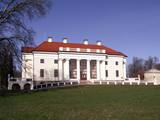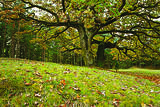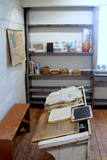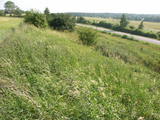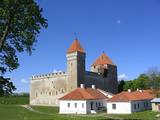| Нo | Название | Описание |
|---|---|---|
|
2012. gadā tika izveidots ģimenes uzņēmums "Bioorganic earthworm compost", kurš nodarbojas ar organiskā mēslojuma - sliekkomposta jeb biohumusa ražošanu. Ir izveidota moderna sliekkomposta ražotne, kura ir viena no lielākajām Baltijas valstīs. Pieaugot cilvēku interesei par zaļo saimniekošanu un iespējami kvalitatīvāku ekoproduktu iegūšanas iespējām, tiek piedāvātas ekskursijas pa ražotni, lai parādītu, kā tiek ražots viens no visefektīvākajiem organiskajiem mēslojumiem - sliekkomposts. |
||
|
Пейзажный парк усадьбы Пакруойис, чья структура сохранилась до наших дней, был разбит в 1850–1860 гг. С одной стороны естественную границу территории образует полоса запруженной реки Круойи, а с другой парк обнесен оградой из диких валунов. Согласно популярной в те времена английской схеме формирования парков преимущество отдавалось дикой природе и имитации естественности. В парке растет около 26 наименований деревьев, среди которых можно найти и редчайшие растения из различных уголков мира, привезенные сюда более сотни лет назад. |
||
|
В исторических источниках упоминается уже в 1582 году. В Дундагской ваковой книге 1736 года в Вайде упоминаются два двора - Лекши и Жонаки. Согласно данным переписи весной 1935 года в Вайде проживало 106 человек, в том числе 40 ливов, 60 латышей, несколько эстонцев и немцев. В 1939 году в деревне Вайде был 21 двор. В Лажах Вайде родился Ника Полманис (1823 - 1903) - первый образованный лив, и всю жизнь прожил ливский поэт Альфонс Бертольдс (1910 - 1993), который посвятил стихотворение растущему рядом со двором вековому дубу. С Жонаками связан богатый род Бертольдов: ливская сказительница Мария Шалтьяре, капитан морских яхт Андрейс Бертольдс (США), его сын, ученый - библиотекарь Артурс Бенедиктс Бертольдс (США), ливский поэт Альфонс Берольдс, знатоки ливского языка Паулина Клявиня и Викторс Бертольдс, швейцарский врач Марселс Бертольдс, всемирно известный пианист Артурс Озолиньш (Канада) и Гризельда Кристиня (1910-2013) – сказительница ливского языка и поэтэсса, которая была последним носителем ливского языка, для которого это был родной язык. Озолниеки также связаны с родом Бертольдов – знатоком ливских традиций и языка Паулиной Клявиней (1918 - 2001) и ее матерью – ливской сказительницей Катриной Зебергой. Коллекцию ливских этнографических предметов, собранную Паулиной, можно осмотреть в Латвийском этнографическом музее под открытым небом – в амбаре ливского двора «Делини». В Пурвзиеды Вайде можно осмотреть коллекцию рогов лесных животных, собранную лесником Эдгарсом Хаусманисом. |
||
|
На втором этаже библиотеки размещены традиционные исторические предметы Юркалне и суйтов, установлены несколько ткацких станков, где местные жители проводят творческие мастерские. Записавшись предварительно, желающие могут послушать рассказ гида о суйтской культуре и традициях, а также посмотреть фильм. |
||
|
Found in the northern part of Cesvaine, the church was built of fieldstones in the Neo-Gothic style in 1879 by the architect Paul Max Bertschy. The church was restored in 1929 and again in the early 1990s. The altar painting, “Christ on the Cross” (1923) is by Jēkabs Bīne.
|
||
|
Строительство дворца господской усадьбы (родовая собственность графов Борхов) началось в начале XIX века, а закончилось шестью десятилетиями позже. В советское время во дворце размещались разные учреждения, а в 1978 г. возник пожар, в результате которого пострадала верхняя часть здания.Дворец не восстановлен и подлежит осмотру только снаружи.Усадьбу опоясывает один из самых выдающихся ландшафтных парков Латвии (середина XIX века). Комплекс господской усадьбы желательно осматривать в сопровождении Ирены Кяркуж, которая во время экскурсии рассказывает интересные предания и поет на латгальском языке! |
||
|
This territory protects the shore of the onetime Baltic lake of ice, which most significant part stretches for 10 kilometres on the eastern side of the Grobiņa-Ventspils highway from Kapsēde till Vērgale bus stop. From the top of this ancient shoreline there is a lovely view of the Piejūra lowlands, but no specific viewing areas or information stands have been installed. There are protected species and habitats in the territory. |
||
|
Lai arī dievnama pirmsākumi meklējami 18. gs. sākumā, tā celtniecību (arhitekts Johanns Eduards de Vite) pabeidza viena gada laikā 1834. – 1835. g. (vēlīnā klasicisma stils). Būvniecības darbus finansēja Krievijas cars. Gan baznīcas atrašanās piejūrā, gan arī tās nosaukums liecina, ka tā celta, godinot Svēto Nikolaju, kas ir visu jūrnieku un zvejnieku aizbildnis. Baznīca apskatāma arī no iekšpuses, kur uzmanība jāpievērš ērģelēm un altārgleznai (1888. g.). |
||
|
Винодельня Allikukivi расположилась в старинном доме директора суконной фабрики. Гостей приглашают на просторный балкон поместья, где они могут продегустировать разнообразные напитки, узнать секреты приготовления вина, историю поместья и посмотреть, как растут ягоды. Производство фруктовых и ягодных вин по эстонским рецептам. |
||
|
Atrodas vēsturiskā rātslaukuma dienvidu malā. Jaunā rātsnama celtniecība (itāļu renesanses stilā, arhitekts O. Dīce) tika pabeigta 1860. gadā. Iespaidīgo celtni, kas nulle kā atjaunota, ir vērts apskatīt gan no āra, gan iekšpuses. Ir restaurēts rātsnama pulkstenis, ārējā fasāde, iekšējie interjeri un Lielā zāle. |
||
|
Тур из Риги в Таллинн представляет собой комбинацию природного и культурного наследия и включает в себя красивейшие пейзажи, а также 15 природных троп, которые пересекают болота, луга и леса вдоль побережья Балтийского моря, включая несколько охраняемых природных резерватов. Многие тропы оборудованы вышками для наблюдения за птицами. На лугах Ранду около Айнажи представлена одна треть всех видов растений Латвии. Дощатый настил для прогулок выведет вас к наблюдательной платформе, с которой можно увидеть луга и море. На острове Сааремаа увидите очень интересные и совсем иные, отличные от материка, природные достопримечательности - доломитные скалы, можжевельниковые пустоши, метеоритное озеро и скалистый берег моря. Маршрут проходит вдоль деревенских фермерских хозяйств и традиционных деревень, типичных для прибрежных областей. Остров Хииумаа — спокойное место, с типичной для Эстонии атмосферой, где находится важный резерват для птиц в заливе Кайна, необычный Сааре Тирп, а также несколько небольших островков вблизи его юго-восточного побережья. А на материке, на полуострове Палдиски, есть возможность ознакомиться с недавним прошлым в виде его бывшей советской военной базы. |
||
|
Ekskursijas laikā apmeklējiet dabas taku, kurā ir iespēja iepazīt Amatas novada dabas objektus gar Kumadas upes, Dančupītes un Amatas upes krastu. Pēc tam apmeklējiet Cēsu pils kompleksu. Viduslaiku pils sniedz iespēju iejusties 800 gadus tālā pagātnē, uzkāpt ar sveču lukturīšiem Rietumu tornī, nokāpt cietumā, kā arī redzēt, kā kalējs darina latgaļu rotas. Blakus esošā Jaunā pils ir 18. gs. celta pilsmuižas kunga māja, kurā tagad atrodas Cēsu Vēsture un Mākslas muzejs. Ekskursijas noslēgumā dodieties uz lauku māju Smiltenes novadā, lai iepazītu maizes cepšanu pēc sentēvu tradīcijām, kā arī pašiem izveidot savu maizes kukulīti. |
||
|
Этот тур рассчитан на семейный отдых. В нем культурные и природные достопримечательности сбалансированы с множеством забав для детей. Маршрут включает в себя несколько ферм, где можно понаблюдать за домашними животными и Природные тропы Лигатне, где можно увидеть диких животных. На пути есть несколько средневековых замков и живописных городов. Побережье моря встретит Вас песчаными пляжами и рыбацкими деревушками, где Вы сможете отведать копченой рыбы. Национальные парки Гауя и Слитере предложат Вам несколько природных троп и живописные пейзажи. |
||
|
Biškopības produkti bioloģiskajā saimniecībā, informācija par biškopību un dabas aizsardzību. |
||
|
Маршрут проходит по территории природного парка «Излучины Даугавы». Парк создан с целью сохранения уникальных ландшафтов древней долины Даугавы, биологического многообразия и богатейшего культурно-исторического наследия. Наибольшую высоту берега реки достигают в т.н. «Воротах Даугавы», где возвышаются Верверский и Слутишкский обрывы. С Приедайнской смотровой вышки открывается вид на древнюю долины Даугавы с высоты птичьего полета. В 2015 году в Васаргелишках и на горе Лаздукалнс были построены новые смотровые вышки. Информация о маршруте от Latvijas Lauku forums |
||
|
Здесь ждут в гости как группы, так и индивидуальных посетителей. Хозяева предлагают насладиться баней по-черному, пообедать и попробовать испеченного по древним рецептам суйтского хлеба, пирогов и особого печенья с семечками. |
||
|
История каменного замка уходит к 13-ому веку . В подвальных залах замка постоянные выставки, которые представляют природу и историю Сааремаа. В замке с мая по август действуют ремесленные мастерские (кузница, обработка стекла, гончарная мастерская, обработка камня), предлагая гостям как усладу для глаз , так и радость творчества для рук. Интерес представляет и расположенный поблизости тир для стрельбы из лука, где после попадания в цель можно самому чеканить монеты. Из филиалов Сааремааского музея советуем посетить хутор-музей Михкли на западе Сааремаа (деревня Вики, волость Кихельконна; +372 454 6613, www.saaremaamuuseum.ee), где можно увидеть как архитектурные достопримечательности, так и объекты культурного наследия. |
||
|
Die größte Bernsteinausstellung im Baltikum (seit 1963) mit Bernsteineinschlüssen. Ist die Bedeutung des Bernsteins in der Geschichte des baltischen Völkern wiedergespiegelt. Das Museum ist in einem dem Grafen Tyszkiewicz (1865 – 1932) gehörteten Schloss (gebaut 1897) eingerichtet. |
||
|
Господский дом усадьбы называют одним из самых выдающихся памятников классицизма Латгалии. Он строилсяс 1783 по 1789 гг. (итальянский архитектор Винченцо Мацотти) как собственность графа Михаила Иоганна Борха. В конце 18 в. по проекту этого же архитектора создавался в романтическом стиле ландшафтный парк(один из первых в Латвии). Сейчас во дворце размещен музей Вараклянского края. |
||
|
Маршрут пролегает от столицы Риги Латвии, через красивые сельские территории до Каунаса, который является вторым по величине городом в Литве. Ландшафтный сад и парк Клугов славятся бегониями. В Добельском садоводческом институте имеется коллекциями из более чем 200 видов и сортов сирени. Сад красивых и практичных идей может похвастаться своей коллекцией хвойных деревьев, а гостям предлагают порошки из пряных трав, сушеные ягоды и фрукты. «Чай гномов» - одно из самых больших хозяйств по выращиванию лекарственных трав в Латвии (выращивают эхинацею, ноготки, ромашку и др.). В Кроньауце в период цветения вы можете насладиться красотой пионов в коллекционном саду Андра Беркина и великолепном тюльпановом саду Виестардов. Следующая остановка находится в фермерском хозяйстве «Дроши веселс», которое производит травяные мази и выращивает овощи. Посетив Домик перечной мяты, вы сможете насладиться мятным чаем, печеньем, медом с мятой и мятным сиропом. В усадьбе Бланкенфельде вы можете осмотреть уникальную коллекцию колоколов, насладиться натуральными соками, сиропами и маринованными огурцами, произведенными в усадьбе. В Йонишкисе посетите красно-белую Йонишкскую синагогу, Церковь вознесения Святой Девы Марии и Музей истории и культуры Йонишкиса. Усадьба Якишкяй не отремонтирована и сохранила оригинальные элементы, такие как, например, печи, ставни, лестницы, двери. В Балтийском музее выращивают около 30 различных видов и сортов растений. В Шяуляйском ботаническом саду созданы три сада старинных растений в соответствии с сельскими традициями соответствующего периода - довоенного, межвоенного и послевоенного. Бурбишское поместье со своим ландшафтным и скульптурным парком организует ежегодный фестиваль тюльпанов. В Клебонишкяйский музее сельских домов можно осмотреть аутентичные хозяйства Аугштайтского региона. Поместье Байсогалас называется королевским, поскольку когда-то оно принадлежало великому князю литовскому, и его парк площадью 12 гектаров является одним из самых красивых в Литве. В музее известного литовского поэта Мачюлиса-Майрониса есть два красивых культурно-исторических сада. Домашние "счастливые блюда" можно приобрести в хозяйстве Гарси Тила, где также можно отправиться на прогулку по их 100-летнему фруктовому саду и осмотреть сад с травами. Литовский институт садоводства занимается как научной, так и экспериментальной / производственной деятельностью. Здесь вы можете приобрести саженцы, а также сезонные фрукты и овощи. В хозяйстве Тадаса Иванаускаса у парка Обелинес вы можете увидеть коллекцию из 300 видов и сортов растений, включая самое старое дерево - гинкго двулопастный. В Каунасе вы можете увидеть самую старую яблоню в Литве – ей почти 360 лет, она 8 метров в длину, 285 см в диаметре на высоте около 1,3 метра. В Каунасском ботаническом саду университета Витаутаса Великого растут уникальные растения, обустроена самая большая оранжерея в Литве, старинные литовские клумбовые растения представлены по разным растительных группам в соответствии с ботанической классификацией. Маршрут заканчивается в Каунасе, который был столицей Литвы с 1920 по 1939 год. |
||


